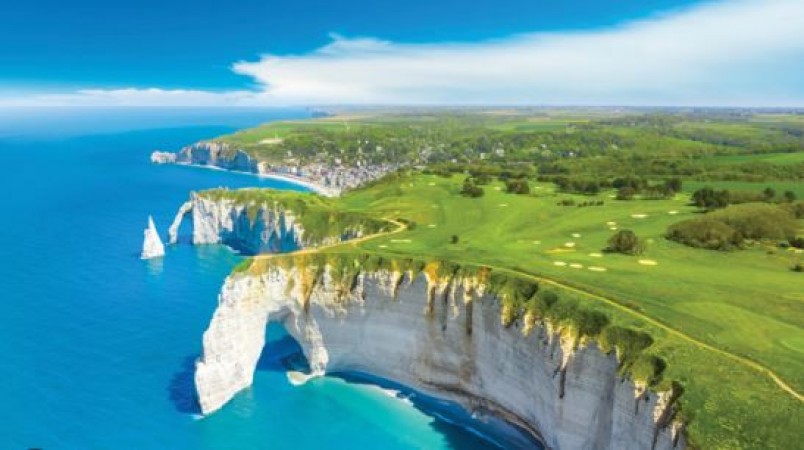
Normandy, a region situated in the northwest of France, is steeped in history, beauty, and cultural significance. With its charming countryside, breathtaking coastline, and historical landmarks, Normandy has captivated travelers for centuries. This article explores the rich tapestry of Normandy's past and present, highlighting its pivotal role in shaping the course of European history and its allure as a must-visit destination for tourists worldwide. Normandy, or in French, "Normandie," is a historic and picturesque region located in the northwest of France.
It is bordered by the English Channel to the north, the region of Hauts-de-France to the northeast, Île-de-France to the east, Pays de la Loire to the south, and Brittany to the southwest. With its stunning coastline, charming countryside, and significant historical sites, Normandy has become a popular destination for tourists from around the world.
A Historical Tapestry: Normandy's history dates back to ancient times, but its most significant chapter began with the arrival of the Norsemen in the 9th century. Rollo, a Viking leader, established the Duchy of Normandy in 911 AD after striking a deal with King Charles III of West Francia. The subsequent rulers, including William the Conqueror, left an indelible mark on the region, culminating in the famous Battle of Hastings in 1066, when William invaded England and changed the course of English history. Normandy's history is deeply intertwined with its strategic location and the people who settled in the region over the centuries.
The area was originally inhabited by Celtic and Gallic tribes before the arrival of the Romans in the 1st century BC. In the 9th century AD, the Vikings, led by Rollo, established the Duchy of Normandy after reaching a treaty with the French king. This Viking heritage is reflected in the region's name, as "Normandy" is derived from "Northman's Land." One of the most pivotal events in Normandy's history was the Norman Conquest of England in 1066. William the Conqueror, Duke of Normandy, defeated King Harold II of England at the Battle of Hastings and subsequently became William I of England. This conquest forever linked the destinies of England and Normandy.
Mont Saint-Michel: One of Normandy's most iconic landmarks, Mont Saint-Michel, stands majestically atop a rocky islet, seemingly floating on the horizon. This medieval abbey, a UNESCO World Heritage Site, is a marvel of architectural prowess and spiritual significance. Its tides and ethereal beauty attract millions of visitors each year, making it a symbol of Normandy's spiritual and cultural heritage.
The D-Day Landings: Normandy's coastal landscape witnessed one of the most pivotal moments of the 20th century during World War II. On June 6, 1944, the Allies launched a massive invasion known as D-Day, turning the beaches of Normandy into battlegrounds. The bravery and sacrifice of the soldiers who stormed the shores, coupled with the enduring significance of this event in ending the war, make the D-Day landing sites a hallowed pilgrimage for history enthusiasts.
ALSO READ :5 Popular Temples In Andhra Pradesh
Honfleur and Impressionism: The picturesque port town of Honfleur has been an inspiration for artists throughout the ages. Its picturesque harbor, cobbled streets, and charming houses served as a muse for famed artists like Claude Monet and Eugène Boudin, who were pioneers of the Impressionist movement. Visitors can still experience the allure of Honfleur's artistic heritage while strolling through its art galleries and exploring the celebrated Vieux Bassin.
ALSO READ :Engaging Your Audience: 15 Unique Lifestyle Blog Post Ideas for Success
Gastronomy and Culinary Delights: Normandy's culinary traditions are as rich as its history. This region is renowned for its delicious dairy products, especially Camembert and Brie cheeses, along with mouthwatering apple-based products like cider and calvados. Travelers are encouraged to indulge in the delectable Normandy cuisine, which blends fresh seafood from its coastal towns with the finest local produce.
Etretat's Cliffs: Nature's artistry is on full display at the white cliffs of Étretat. These stunning rock formations, immortalized in the works of Monet and other artists, attract hikers and nature enthusiasts alike. The awe-inspiring cliffs, natural arches, and panoramic views of the English Channel create an unforgettable experience for visitors.
ALSO READ :Igniting the Fire Within: Your Top Motivational Quotes
Conclusion: Normandy stands as a testament to the enduring charm of history, culture, and nature. From its medieval heritage to its pivotal role in world events, this region continues to captivate visitors with its picturesque landscapes, cultural treasures, and culinary delights. Whether one seeks to immerse themselves in history, relax on pristine beaches, or indulge in delicious cuisine, Normandy offers an experience like no other. As travelers explore the enchanting towns and historical landmarks, they become part of the timeless tale that is Normandy.
Ultimate Packing Tips for an Unforgettable Trip to XYZ Destination
Marseille, France: Remarkable Cultural Diversity
The Enchanting Charm of Provence: A Journey Through Time and Beauty